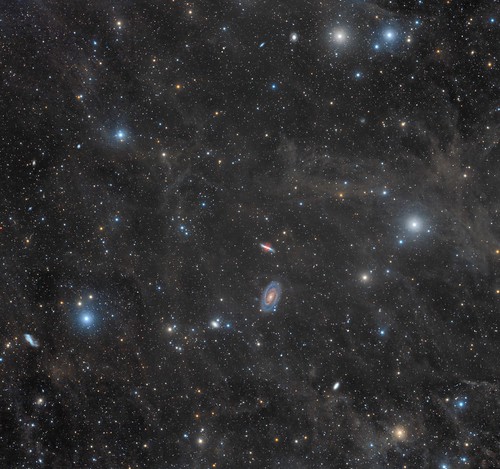Page 4 of 6
Re: Submissions: 2017 March
Posted: Sat Mar 18, 2017 11:32 pm
by ildiora
Trails Of Lights And Fires On Mount Etna - Unesco World Heritage Site
http://www.dariogiannobile.com
Copyright: Dario Giannobile
Sicily - March 2017, The Volcano Etna woke for the second time in a month.
According to Greek mythology, Hephaestus was the craftsman and smith of gods.
The ancient Greeks and Sicilians believed that he had his abode and his forge under the volcano Etna and that the eruptions were the proof of his mighty work.
From ct.ingv.it: "On the morning of 15 March 2017, a new eruptive episode started at Etna's Southeast Crater. The eruptive vent was located in the area of the former "saddle" between the southeast Crater (SEC) and the New Southeast Crater (NSEC). In the early morning hours of 15 March, a small lava flow started oozing down the south flank of the SEC-NSEC cone complex. Then the eruptive activity rapidly intensified with nearly constant Strombolian explosions that generated amounts of volcanic ash dispersed in the atmosphere. The lava flow had reached the base of the cone and was slowly expanding on the gently sloping terrain toward south.”
The landscape was enlightened by the gentle light of the Moon showing the “Sciara”, the black volcanic, rocks covered by a thick layer of snow.
From the top crater a fountain of lava left traces on the sky in front of a curtain of gentle lights pictured by the stars rotating around Polaris.
Re: Submissions: 2017 March
Posted: Sun Mar 19, 2017 7:06 pm
by Sandgirl
Arch of Milky Way over Great Wall
Copyrights: Steed Yu & NightChina.net
Complex N159 in the Large Magellanic Cloud
Credits and Copyrights: Data: Hubble Legacy Archives; ProcessingDomingo Pestana
Bright auroras in solar calm
Copyrights: Juan Carlos Casado
Messer 13
Copyrights: Claudio Bottari
Thin Venus crescent
Copyrights: Shahrin Ahmad
"Great Whale in the Sky” Aurora
Copyrights: Ulf Jonsson
EchoStar 1st & 2nd Stage Streak
Copyrights: Bill Jelen
Zodiacal Light, from home and away - Turkey (top) and Philipines (bottom)
Copyrights: Tunç Tezel
Star trails from Spain, Galicia
Copyrights: Ana García
Rise and set of Venus 2016/2017
Copyrights: Ian H Brock
Surprising intense auroras at Finland
Copyrights: Juan Carlos Casado
Lunar Transit - Bird
Copyrights: Bryan Goff
A dusty Veil
Copyrights: Luigi Fontana
Larger size:
http://www.astrobin.com/full/287001/C/
NGC2170 in Monoceros
Copyrights: Terry Hancock
The Triangulum Galaxy
Copyrights: Patrik Tarczi
Venus in crescent with unusual orientation
Copyrights: Emmanuel Beaudoin
Easter Island Moai and Orion
Copyrights: Yuri Beletsky
Copyrights: Miguel Claro
Milky Way Above St. George Island, Florida
Copyrights: David Woolsteen
Mushroom Sun with human silhouette
Copyrights: Marcella Giulia Pace
Last Days of the Evening Star
Copyrights: Jean-Francois Graffand
Rosette Nebula
Copyrights: Bouhaddou Abdelkrim
Orion Nebula
Copyrights: Mariusz Szymaszek
Re: Submissions: 2017 March
Posted: Sun Mar 19, 2017 10:06 pm
by matt_quinn
ISS passing over Algonquin
I captured an early morning International Space Station transit through the Milky Way arching over the lake of two rivers in Algonquin Provincial Park here in southern Ontario, Canada. I took 5 images of the ISS doing its fly by and then I panned the camera as you would in a normal panoramic image. I composited the 5 ISS paths into one frame and merged it with the panoramic to achieve the final result. All the images were captured within 3-4 minutes of each other.
https://mattquinn.photography
Copyright: Matt Quinn
https://mattquinn.photography/media/CAC ... 76e17f.jpg
Re: Submissions: 2017 March
Posted: Mon Mar 20, 2017 10:57 am
by luigifontana
The "real" colors of interstellar dust
Copyright: Luigi Fontana and Edoardo Radice

Full image:
http://www.astrobin.com/286480/C/
The colors of this image of the zeta Orionis area have been carefully calibrated to match the response of the human eye. The h-alpha radiation (background of the Horsehead Nebula) is red. The small reflection nebula NGC2023, near the center of the image, is blue; it is excited primarly by UV radiation from the bright and young star HD37903, clearly visible in the middle of the nebula. Finally the Flame Nebula, NGC2024, is NOT illuminated by zeta Orionis itself (that is much closer than the nebula) but probably by a cluster of young stars. The "neutral" color of this nebula is a mix of excited gas and reflection.
Re: Submissions: 2017 March
Posted: Mon Mar 20, 2017 11:24 am
by Rothkko
Re: Submissions: 2017 March
Posted: Mon Mar 20, 2017 1:06 pm
by Hermann von Eiff
A butterfly in the clouds of the Milky Way
Copyright: Hermann von Eiff
Re: Submissions: 2017 March
Posted: Mon Mar 20, 2017 2:45 pm
by Rothkko
the seven differences, sun and moon
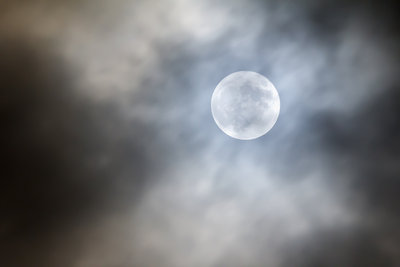
- mérida, spain. 2014-11-23 and 2015-10-27, 12:45 and 22:39
equiv. 640mm, 1 shot, polarized filter
Re: Submissions: 2017 March
Posted: Mon Mar 20, 2017 11:13 pm
by Adrien Mauduit
Stranded under the zodiacal lights of Denmark
http://www.adphotography-online.com
Copyright: Adrien Mauduit
The picture was taken on Høve beach in Denmark on Sat. 19th March 2017, in the company of the milky way an the zodiacal lights at its peak (halo of light reflects from inter-planetary dust particles). As I sat on the boat facing the foamy gusts of wind, I was able to contemplate a lot of deep-sky objects. However we are nearing the end of the Orion season at upper mid-latitudes, and it might be one of the last pictures of it before next winter!
Canon 6D Baader mod + Samyang 24mm f/1.4, 14 x 13'' @ ISO 6400, f/3.2.
Re: Submissions: 2017 March
Posted: Tue Mar 21, 2017 11:40 am
by alfredoxa
[ENGLISH]
Jökulsárlón is Iceland's largest and most famous glacier lake. It is situated at the southern end of the Vatnajökull glacier, between the Skaftafell National Park and the town of Höfn. It appeared for the first time in 1934-1935 and in 1975 it went from 7.9 km² to the present 18 km², due to the accelerated fusion of the Icelandic glaciers. It has a maximum depth of approximately 200 m, which makes it probably the second deepest lake in Iceland.
The boreal aurora reflected on the icy lake, the glaciers moving in a timelapse sequence and venus hiding behind the mountains forms an overwhelming landscape.
[SPANISH]
Jökulsárlón es el mayor y más conocido lago glaciar de Islandia. Está situado en el extremo sur del glaciar Vatnajökull, entre el Parque nacional Skaftafell y la ciudad de Höfn. Apareció por primera vez en 1934-1935 y en 1975 pasó de 7,9 km² a los actuales 18 km², debido a la acelerada fusión de los glaciares islandeses. Tiene una profundidad máxima de aproximadamente 200 m, lo que lo convierte probablemente en el segundo lago más profundo de Islandia.
Las auroras boreales reflejadas sobre el lago helado, los glaciales moviendose en una secuencia timelapse y venus ocultándose tras las montañas forman un paisaje sobrecojedor.
 Venus on the Jokulsarlon glacial lagoon with Northern Lights
Venus on the Jokulsarlon glacial lagoon with Northern Lights by
Alfredo Madrigal, en Flickr
Hale-Bopp 20 Years ago
Posted: Tue Mar 21, 2017 5:35 pm
by Sebastian Voltmer
Hale-Bopp on March 29, 1997 above Sion in the Rhone Valley, Switzerland.
12 sec exposure on Kodak Ektacolor Pro Gold 400 (GPY) using a 50 mm f/1.7 lens.
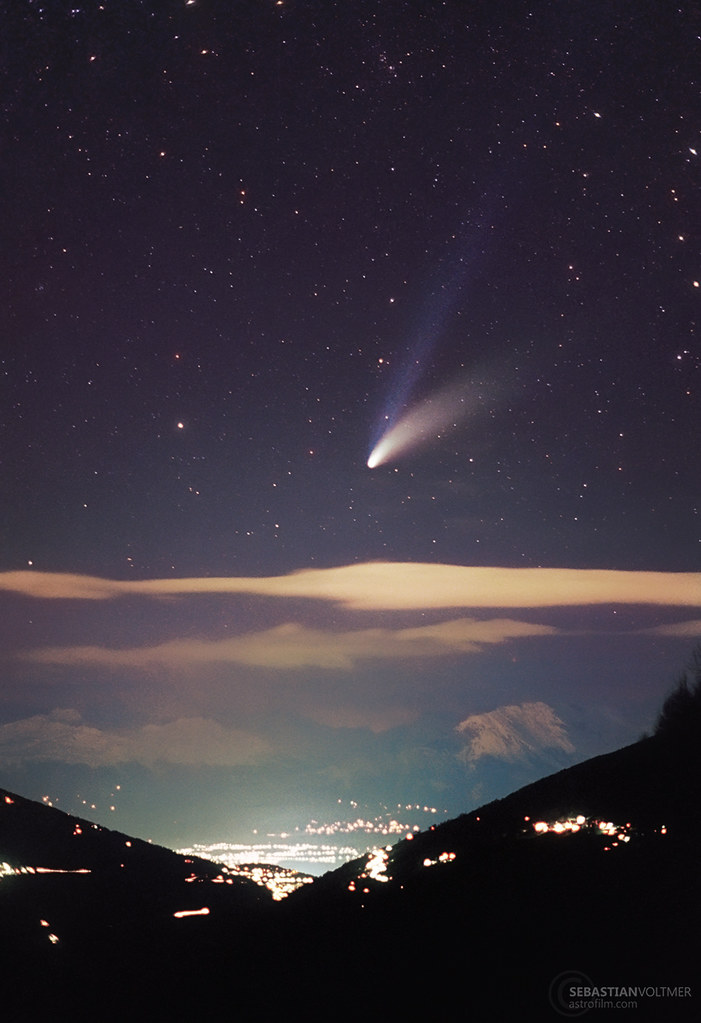
Hale-Bopp on April 3, 1997. The blue ione tail crosses the double star cluster h & chi in Perseus and reaches the Heart- and Soul Nebula. 20 min exposure on Kodak EPP 100 (gas-hypersensitized) with a 50 mm lens. Taken from Gornergrat (3150 m), Switzerland.
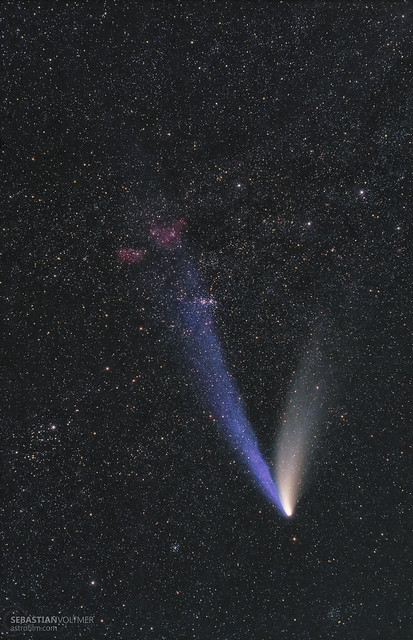
Flickr:
https://www.flickr.com/photos/spacemovi ... 9969484470
e-mail:
sebastian@voltmer.de
web:
http://www.voltmer.de
Re: Submissions: 2017 March
Posted: Tue Mar 21, 2017 9:22 pm
by sternklar
Witch Head Nebula (IC 2118) and Rigel, Namibia, Sept. 02 2016
http://www.sternklar.ch/images-webpages ... ept-16.htm
Exposure data:
Carl Zeiss Apo Sonnar T* 135 mm f/2.0 ZE @ f/2.8 with Canon EOS 6Da. Exposure time: 21 x 5 minutes @ 800 Asa.
Copyright: Manuel Jung,
http://www.sternklar.ch
Re: Submissions: 2017 March
Posted: Wed Mar 22, 2017 12:57 pm
by alfredoxa
[ENGLISH]
The lunar crown is an optical phenomenon produced by the diffraction of disc-shaped light around the moon. The crown is caused by suspended ice particles in the troposphere that refract light and generate a spectrum of colors. In this case I was lucky that it was triple, an extremely rare event.
[SPANISH]
La corona lunar es un fenomeno optico producido por la difraccion de la luz en forma de disco alrededor de la luna. La corona es causada por partículas de hielo en suspension en la troposfera que refractan la luz y generan un espectro de colores. En este caso tuve la suerte de que fuera triple, un hecho extremadamente raro.
 Lunar corona
Lunar corona by
Alfredo Madrigal, en Flickr
Flux
Posted: Wed Mar 22, 2017 2:19 pm
by alcarreño
Re: Submissions: 2017 March
Posted: Wed Mar 22, 2017 6:03 pm
by j.s.ebersole
Stellar Jet in Carina – Hubble Legacy Archive
http://jebersol.zenfolio.com/
Copyright: John Ebersole
Narrowband HLA images from the WFC3 UVIS camera were combined in the classic HST palette.
Comet 41P/Tuttle–Giacobini–Kresák
Posted: Wed Mar 22, 2017 6:45 pm
by jfgout
Hi everyone, here is my contribution to March with the comet 41P/Tuttle–Giacobini–Kresák cruising by the galaxy M108 and the planetary nebula M97.
Although it looks like the comet his headed for the galaxy (m108), there is no risk of collision. Indeed, the comet is very close to Earth, at 'only' about 20 millions kilometers (~75 seconds at the speed of light) while the galaxy is 46 million light years away. That's quite a gap...
Also visible in the image are the planetary nebula m97 (commonly called the Owl Nebula) ~2,000 light years from us, and the star FI UMa (332 light years away) which is just below the threshold of visibility with the unaided eye.
These different objects help visualizing the cosmic perspective on this 2D image.

Full resolution:
https://photos.smugmug.com/photos/i-Bth ... thhvWS.jpg
With the annotations:

Full resolution:
https://photos.smugmug.com/photos/i-FRn ... RnR4fs.jpg
Image is from stacking 50 individual exposures of 1 minute each, taken on Wednesday, March 22, 2017 between 2am and 3am (EST). The motion of the comet is obvious and the small gaps in the comet's position correspond to frames that had to be removed because of technical problems (mostly blurry images because of strong wind gusts).
Gear: Telescope C8 edge-hd (8-inch Schmidt-Cassegrain) on german equatorial mount (CGEM) and camera Canon 5D Mark II. Drove 25 minutes to escape the lights from the city (Bloomington, Indiana) and get some fairly dark skies on the shores of Monroe lake.
While taking the pictures, I also looked at the sky and saw two beautiful shooting stars. That was a good night, worth going to bed at 4am...
Here is also a GIF showing the motion of the comet during an hour:
https://photos.smugmug.com/photos/i-S7p ... 7pVt8P.gif
Unfortunately, a small particle of dust was 'dancing' on my camera sensor, just in the area where the comet was...
Hope you guys enjoy these images !
Best,
Jean-Francois
Hale-Bopp rocks
Posted: Wed Mar 22, 2017 10:13 pm
by Sebastian Voltmer
Comet Hale-Bopp on March 27, 1997 between two rocks, taken at the French-Italian border from the “Col de La Traversette” next to La Rosière. 12 seconds exposure on Kodak GPY 400 using a 50 mm f/1.7 lens.
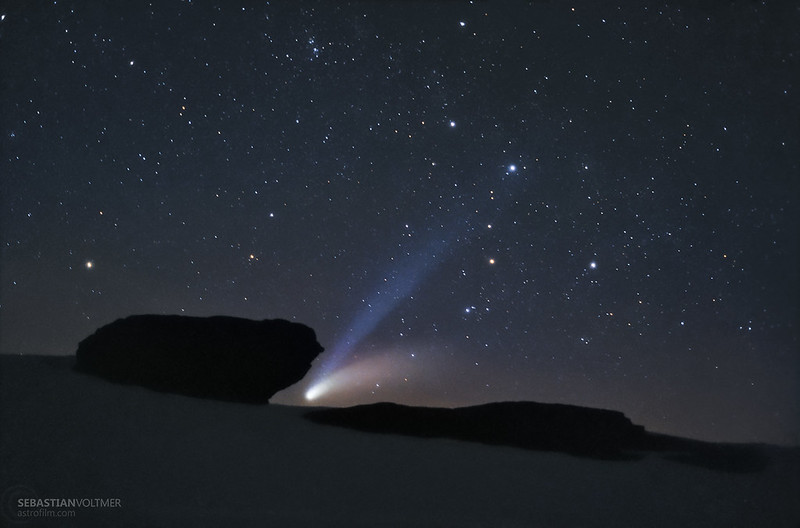
download original:
https://www.flickr.com/photos/spacemovi ... 2/sizes/o/
e-mail:
sebastian@voltmer.de
web:
http://www.voltmer.de
Hale-Bopp on April 4, 1997
Posted: Wed Mar 22, 2017 10:36 pm
by Sebastian Voltmer
Comet Hale-Bopp on April 4, 1997. 10 min exposure using a 300 mm lens on Kodak Ektacolor Pro Gold 1000 (GPZ).
Taken from Gornergrat (3,150 m), Switzerland.
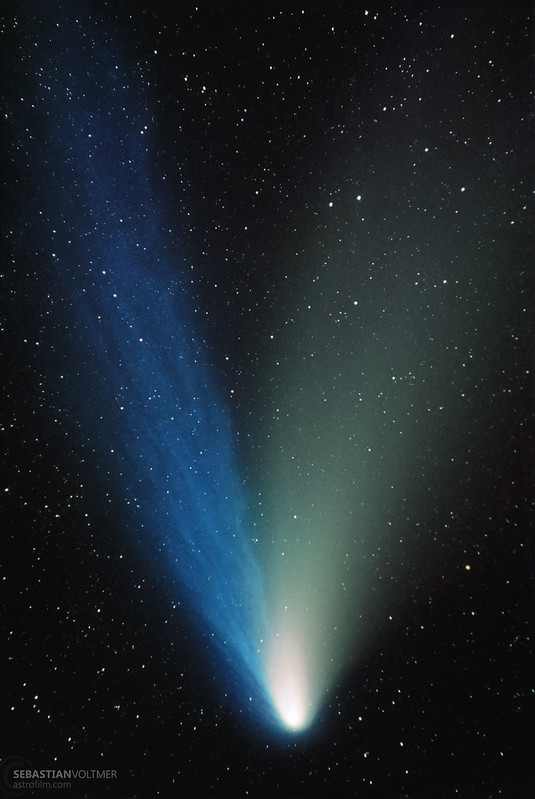
Original:
https://c2.staticflickr.com/4/3764/3357 ... cc_o_d.jpg
Re: Submissions: 2017 March
Posted: Thu Mar 23, 2017 3:00 am
by marctoso
Ceremonies on the Edge
http://www.ancientskys.com
http://www.facebook.com/AncientSkys/
Copyright: Marc Toso
This past week I had the opportunity to explore some Chacoan structures outside of the Chaco Culture National Historical Park in New Mexico. This a fabulously desolate area of BLM land surrounded by the Navajo reservation. A kind and elderly Navajo man gave us permission to camp among his cows, even though he warned us that they were “man-eating cows.”
This kiva is perched on a narrow ridge of sand in the middle of a wash, teetering on the edge. Lots of rubble is strewn on the hard-pack below. It is an usual and amazing site. Multiple kivas sit in balance, giving the site the feeling of deep ceremonial significance. Around 1000 years ago the architects of this place walked away.
This land is outside of the Chaco Cultural Historical. The earth is barren and the skies are black. Many of the lands in the Chaco Canyon greater area are leased by oil and gas companies. I fear their lights may at some point dot these views. Hopefully on my next visit this sky and land will still remain empty.
I attempted a new lightning technique on this trip. Since there were no mountains or hills blocking the horizon I began taking a series of photos right when the moon was rising in the east. I hoped to achieve a balance of just enough moonlight for the land while the sky remained dark for the stars.
Sirius, the Dog Star, in the constellation Canis Major is visible in the central frame, as well as Orion on the far right.
Re: Submissions: 2017 March
Posted: Thu Mar 23, 2017 6:25 am
by Astromontufar
alfredoxa wrote:[ENGLISH]
The lunar halo is an optical phenomenon in the form of a disk around the moon. The halo is caused by suspended ice particles in the troposphere that refract light and generate a spectrum of colors. In this case I was lucky that it was triple, an extremely rare event.
[SPANISH]
El halo lunar es un fenomeno optico en forma de disco alrededor de la luna. El halo es causado por partículas de hielo en suspension en la troposfera que refractan la luz y generan un espectro de colores. En este caso tuve la suerte de que fuera triple, un hecho extremadamente raro.
 Triple lunar halo
Triple lunar halo by
Alfredo Madrigal, en Flickr
Hi, that´s not a lunar halo, thats a lunar corona, check the scientific explination here:
https://apod.nasa.gov/apod/ap150615.html , cheers.

Re: Submissions: 2017 March
Posted: Thu Mar 23, 2017 7:54 am
by IO_12
Comet, planetary, galaxies
Comet 41P/Tuttle–Giacobini–Kresák near M 97 and M 108 on 22.03.2017
Copyright: Velimir Popov, Emil Ivanov
Irida Observatory
More info and hi-res images on
website
Re: Submissions: 2017 March
Posted: Thu Mar 23, 2017 11:30 am
by alfredoxa
Hi Sergio, thanks for the clarification! I've already corrected it, by the way, awesome your APOD 2015!
Astromontufar wrote:alfredoxa wrote:[ENGLISH]
The lunar halo is an optical phenomenon in the form of a disk around the moon. The halo is caused by suspended ice particles in the troposphere that refract light and generate a spectrum of colors. In this case I was lucky that it was triple, an extremely rare event.
[SPANISH]
El halo lunar es un fenomeno optico en forma de disco alrededor de la luna. El halo es causado por partículas de hielo en suspension en la troposfera que refractan la luz y generan un espectro de colores. En este caso tuve la suerte de que fuera triple, un hecho extremadamente raro.
 Triple lunar halo
Triple lunar halo by
Alfredo Madrigal, en Flickr
Hi, that´s not a lunar halo, thats a lunar corona, check the scientific explination here:
https://apod.nasa.gov/apod/ap150615.html , cheers.

Hale-Bopp maga-zoom
Posted: Thu Mar 23, 2017 12:18 pm
by Sebastian Voltmer
Animation containing several photos of comet Hale-Bopp taken in April 1997.
http://www.astrofilm.com
Copyright: Sebastian Voltmer
First shot: Hale-Bopp on April 3, 1997. The blue ione tail crosses the double star cluster h & chi im Perseus and reaches the Heart- and Soul Nebula. 20 min exposure on Kodak EPP 100 (hyp.) with a 50mm lens. Taken from Gornergrat (3150 m), Switzerland.
Second shot: 10 min exposure using a 300 mm lens on Kodak Ektacolor Pro Gold 1000 (GPZ).
Third shot: Coma and streamer of Hale-Bopp. 10 min exposure using a C8 telescope @ 1230 mm f/6.3 on Kodak EPP 100 (hyp.)
Fourth shot: The False Nucleus of Hale-Bopp on April 3, 1997. Eyepiece projection through a C8 telescope. Taken from Gornergrat (3150 m), Switzerland.
Cheers,
Sebastian
Re: Submissions: 2017 March
Posted: Thu Mar 23, 2017 1:55 pm
by GerminianiMaicon
NGC 3576: The Statue of Liberty Nebula
TS 115/800
ZWO ASI 1600 mono cooled
PixInsight + PS6
HaRGB
5 hours H-Alpha 12nm
40 minutes each channel RGB
Total: 7 hours
Re: Submissions: 2017 March
Posted: Thu Mar 23, 2017 2:25 pm
by alfredoxa
[quote="alfredoxa"][ENGLISH]
Lying in the snow observing the magnificent aurora borealis in front of the crater Grænavatn (Krýsuvík - Iceland). A crater maar type probably about 6000 years old.
[SPANISH]
Tumbado en la nieve observando las magníficas Auroras boreales frente al crater Grænavatn (Krýsuvík - Iceland). Un crater de tipo maar probablemente de unos 6000 años de antiguedad.
 Watching the auroras
Watching the auroras by
Alfredo Madrigal, en Flickr
Re: Submissions: 2017 March
Posted: Fri Mar 24, 2017 11:26 am
by Stefan Westphal
The Plejades Messier 45
Copyright: Stefan Westphal
More Data can you see here:
http://www.astrobin.com/282478/?nc=user







